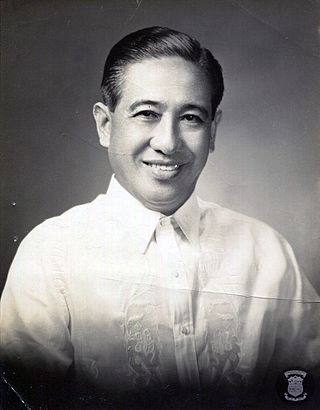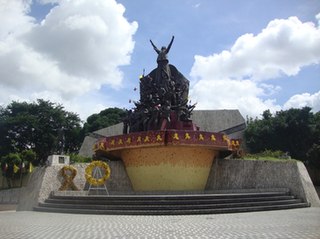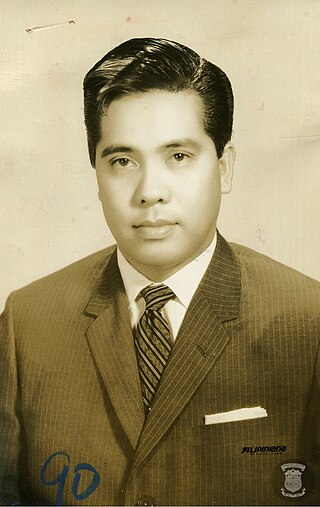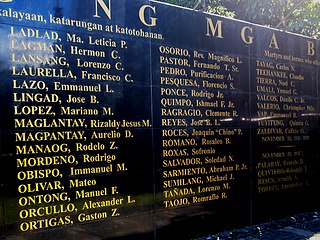Related Research Articles

Benigno "Ninoy" SimeonAquino Jr., was a Filipino politician who served as a senator of the Philippines (1967–1972) and governor of the province of Tarlac. Aquino was the husband of Corazon Aquino, who became the 11th president of the Philippines after his assassination, and father of Benigno Aquino III, who became the 15th president of the Philippines. Aquino, together with Gerardo Roxas and Jovito Salonga, helped form the leadership of the opposition towards then President Ferdinand Marcos. He was the significant leader who together with the intellectual leader Sen. Jose W. Diokno led the overall opposition.

The National Democratic Front of the Philippines (NDFP) is a coalition of revolutionary social and economic justice organizations, agricultural unions, trade unions, indigenous rights groups, leftist political parties, and other related groups in the Philippines. It belongs to the much broader National Democracy Movement and the communist rebellion in the Philippines.

The United Nationalist Democratic Organization (UNIDO) was the main political multi-party electoral alliance of the traditional political opposition during the turbulent last years of Philippine President Ferdinand Marcos in the mid-1980s. It was formed in January 1980, and was originally known as the United Democratic Opposition from 1980 to 1982. It was initially a union of eight major and minor political parties and organizations with the main aim to oust President Marcos through a legal political process. In April 1982, the coalition received its present name, and increased its members to twelve parties. Shortly after the assassination of popular opposition senator Benigno Aquino Jr., the party was led by Senator Salvador Laurel of Batangas.

Lorenzo Martinez "Ka Tanny" Tañada Sr. was a Filipino statesman, lawyer, human and civil rights defender, and national athlete. He is often referred to as the "Grand Old Man of Philippine Politics."
Lakas ng Bayan, abbreviated as Laban, was an electoral alliance, later a political party, in the Philippines formed by Senator Ninoy Aquino for the 1978 Interim Batasang Pambansa regional elections. The party had 21 candidates for the Metro Manila area, all of whom lost, including Ninoy. The party's acronym (Laban) is a Filipino word meaning "fight".

Francisco "Soc" Aldana Rodrigo was a Filipino playwright, lawyer, broadcaster, and a Senator of the Philippines from 1955 to 1967.

The People Power Monument is an 18-meter-high (59 ft) monument built to commemorate the events of the 1986 People Power Revolution. The monument is located on the corner of Epifanio de los Santos Avenue and White Plains Avenue in Barangay Camp Aguinaldo, Quezon City, Philippines. It was made by Eduardo Castrillo in 1993. It is about 0.90 kilometers (0.56 mi) from the EDSA Shrine, another monument built to commemorate the event.

Mamintal Abdul Jabbar Tamano was a Filipino statesman and a former Senator of the Philippines.

Silme Domingo was a Filipino American labor activist. With Gene Viernes, he was murdered in Seattle on June 1, 1981, while attempting to reform the Local 37 of the International Longshore and Warehouse Union (ILWU).

The burial of Ferdinand Marcos, a former Philippine President who ruled as a dictator for 21 years, took place on November 18, 2016, at the Libingan ng mga Bayani in Fort Andres Bonifacio, Taguig, Metro Manila, Philippines. Marcos had been elected the 10th President of the Philippines in 1965, but declared Martial Law in 1972 before his final constitutionally allowed term was over, holding on to power until his overthrow by the People Power Revolution in 1986.
Student activism in the Philippines from 1965 to 1972 played a key role in the events which led to Ferdinand Marcos' declaration of Martial Law in 1972, and the Marcos regime's eventual downfall during the events of the People Power Revolution of 1986.
Religious sector opposition against the dictatorship of President Ferdinand Marcos included leaders and workers belonging to different beliefs and denominations.

During the presidency of Ferdinand Marcos, Filipino workers in the labor industry experienced the effects of government corruption, crony capitalism, and cheap labor for foreign transnational industries, One of the objectives of Martial Law was to cheapen labor costs, in order to attract transnational corporations to export labor to the Philippines. Marcos signed many presidential decrees beneficial only to his associates, while allowing for the forced relocation of indigenous peoples, decreasing workers' wages, and murders of labor activists. Minimum wage was a fixed PHP8.00 per day. Many workers were unemployed or underemployed. It was also during the Marcos presidency when the practice of contractualization began, enabling managements to avoid giving regular, permanent status to employees after six months of work. Strikes were banned and the government controlled trade unions, leaving workers without effective protection against employers who had unfair labor practices and regulations.
Katipunan ng Demokratikong Pilipino (KDP) is a Philippine far-right neo-nationalist political party founded on August 31, 2018. It was formed by supporters of 16th President Rodrigo Duterte, including some officers affiliated with the Citizen National Guard, a nationalist, anti-communist political advocacy group, including party chairman and former Department of Education undersecretary Butch Valdes, President Ramon Pedrosa, Executive Vice President Princess Lady Ann Indanan-Sahidulla, and Dr. Ricardo Fulgencio IV. The party had fielded former Lieutenant General Antonio Parlade Jr. in the 2022 presidential election, which he was disallowed to run by COMELEC.
Alexander "Alex" Orcullo was a Filipino journalist, community leader, and activist known for speaking against the abuses of the dictatorship of Ferdinand Marcos, and for being a seminal figure of the protest movement against the Marcos dictatorship in Mindanao, Philippines.

Gaston Zavalla Ortigas, also known as Gasty was a Filipino professor, freedom fighter, agrarian reformer, entrepreneur, and peace advocate best known for his opposition to the Martial Law dictatorship of Ferdinand Marcos, and for his later pursuit of a peace process between the post-dictatorship Philippine Government and various antidictatorship movements that did not give up their arms after Marcos was deposed in February 1986. He was the dean of the Asian Institute of Management (AIM).

Antonio Gumba Parlade Jr. is a former Filipino military officer who retired as commander of the Armed Forces of the Philippines Southern Luzon Command in 2021, and was best known for his combative terms as spokesman for the Philippine Army before he was removed from that post in 2011, and later, as spokesperson of the National Task Force to End Local Communist Armed Conflict (NTF-ELCAC).

In the Philippines during the dictatorship of Ferdinand Marcos, groups and individuals which opposed the regime without subscribing to leftist ideology were usually labeled with the terms "middle force," "third force," the "mainstream opposition," or more rarely, as the "conservative opposition." Mostly consisting of middle class and upper class groups which had been apolitical when Marcos first declared martial law, the most prominent examples of oppositionists in this category include religious groups, business sector groups, professional groups, social democrats, academics, journalists, and artists. Politicians from the traditional opposition are also sometimes counted in this category, although the terms are traditionally associated with ground level opposition, rather than political opposition per se.
The different forms and trends of protest music against the Marcos dictatorship mostly first became prominent during the period now known as the First Quarter Storm, and continued until Ferdinand Marcos was deposed during the 1986 People Power revolution; some of the trends continued beyond this period either in commemoration of the struggle against the Marcos dictatorship, or in opposition to the political return of the Marcos family to a prominent place in Philippine politics.
Movement for a Free Philippines was a Washington, D.C.-based organization established in 1973 by exiled Filipinos in opposition to the authoritarian regime of Ferdinand Marcos in the Philippines.
References
- 1 2 3 4 5 Toribio, Helen (1998). "We Are Revolution: A Reflective History of the Union of Democratic Filipinos (KDP)". Amerasia Journal. 24 (2): 155–178. doi:10.17953/amer.24.2.00x12jv74uv8p673.
- 1 2 3 4 Bello, M.; Reyes, V. (1986). "ilipino Americans and the Marcos Overthrow: The Transformation of Political Consciousness". Amerasia Journal. 13 (1): 73–78. doi:10.17953/amer.13.1.21h54l86268n023n.
- ↑ Katipunan ng mga Demokratikong Pilipino (July 1973), Katipunan ng mga Demokratikong Pilipino First National Congress, Santa Cruz, CA
{{citation}}: CS1 maint: location missing publisher (link) - ↑ Ignacio Jr., Abraham Flores (1994). "Makibakawa Huwag Matakot: A History of the Katipunan ng mga Demokratikong Pilipino" (PDF). Maganda Magazine (7).
- ↑ Rivera, Patty (September 25, 2016). "Toronto: PH Martial Law survivors recall the years of living dangerously". inquirer.net. Retrieved June 7, 2021.
- ↑ Querol Moreno, Cherie (September 6, 2016). "Bay Area Fil-Ams join protest against hero's burial for Marcos". rappler.com. Retrieved June 7, 2021.